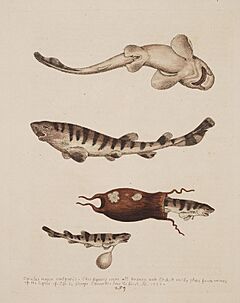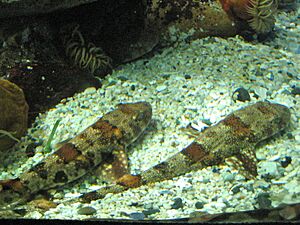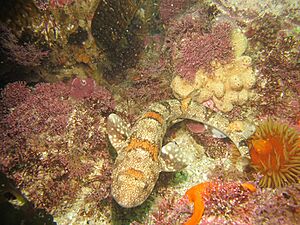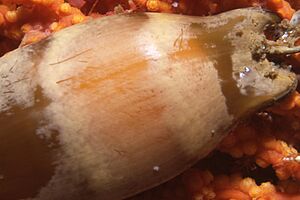Puffadder shyshark facts for kids
Quick facts for kids Puffadder shyshark |
|
|---|---|
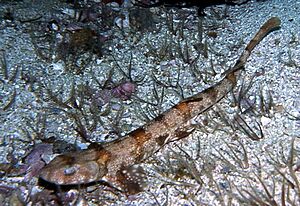 |
|
| Conservation status | |
| Scientific classification | |
| Genus: |
Haploblepharus
|
| Species: |
edwardsii
|
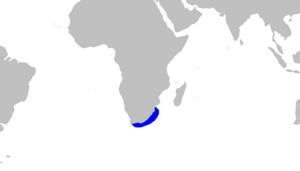 |
|
| Range of the puffadder shyshark | |
| Synonyms | |
|
Scyllium edwardsii Schinz, 1822 |
|
The puffadder shyshark (Haploblepharus edwardsii), also known as the Happy Eddie, is a type of catshark. It belongs to the family called Scyliorhinidae. This shark lives only in the cool waters off the coast of South Africa.
You can often find this common shark on the seafloor in sandy or rocky habitats. It lives from shallow waters near the shore down to about 130 meters (426 feet) deep. The puffadder shyshark usually grows to about 60 cm (2 feet) long. It has a thin, flat body and head. Its back has cool patterns: bright orange, dark-edged "saddles" and many tiny white spots. The Natal shyshark was once thought to be the same as the puffadder shyshark.
When this shark feels scared, it curls up into a circle. It hides its eyes with its tail. This is why it's called a "shyshark" or "doughnut". It hunts and eats mostly crustaceans, polychaete worms, and small bony fishes. Female puffadder shysharks lay their eggs one or two at a time. They attach them to things on the seafloor. This shark is not harmful to humans. Fishermen usually throw it back because it is small. The International Union for Conservation of Nature (IUCN) says this shark is endangered. This is because its home area is small and fishing or pollution could hurt its population.
Contents
What's in a Name?
The first time anyone wrote about the puffadder shyshark was in 1760. An English naturalist named George Edwards drew and described it. He called it Catulus major vulgaris. Later, in 1817, a French zoologist named Georges Cuvier described it as "Scyllium D'Edwards".
In 1822, a Swiss naturalist, Heinrich Rudolf Schinz, gave it its proper scientific name: Scyllium edwardsii. This is why Schinz gets credit for naming the species. In 1913, an American zoologist, Samuel Garman, created a new group called Haploblepharus for this shark and other shysharks.
There used to be two types of puffadder shysharks: "Cape" and "Natal". They looked a bit different and lived in different places. In 2006, the "Natal" type was named a new species, the Natal shyshark. Scientists have studied the shark's DNA to understand its family tree. They found that the puffadder shyshark is one of the oldest members of its family. It is closely related to the dark shyshark and the brown shyshark.
The name "puffadder shyshark" comes from the puff adder snake. This snake lives in Africa and has similar colors. The nickname "Happy Eddie" comes from its scientific name, Haploblepharus edwardsii. Scientists use this name. It's also being used to help people tell this shark apart from other shysharks.
How to Spot a Puffadder Shyshark
The puffadder shyshark is thinner than other shysharks. It has a short, wide, flat head and a rounded snout. Its large, oval eyes look like a cat's eyes. They have a special third eyelid to protect them. The shark's nostrils are very big. They have large skin flaps in front that connect to its mouth.
Its mouth is short with grooves at the corners. It has 26–30 rows of teeth in its upper jaw and 27–33 rows in its lower jaw. Male sharks have longer, three-pointed teeth. Females have shorter, five-pointed teeth. The two halves of the lower jaw are connected by a special cartilage. This helps spread out the teeth and might make its bite stronger.
This shark has five pairs of gill slits on the upper part of its body. Its dorsal, pelvic, and anal fins are all about the same size. The dorsal fins are far back on its body. Its pectoral fins are wide and medium-sized. The short, wide caudal fin (tail fin) is about one-fifth of its body length.
Its skin is thick and covered in small, leaf-shaped scales called dermal denticles. The shark's back is light to dark brown. It has 8–10 bright yellowish to reddish-brown "saddles" with darker edges. Many small white spots cover its whole back. Its belly is white. This shark can grow up to 60 cm (2 feet) long. The longest one ever found was 69 cm (2.3 feet). Sharks found west of Cape Agulhas are smaller, reaching only 48 cm (1.6 feet) long.
Where They Live
The puffadder shyshark lives only on the continental shelf along the coast of South Africa. You can find it from Langebaan Lagoon to the western part of Algoa Bay. Some old reports said it lived as far north as Durban, but those were likely mistakes.
This shark lives on the bottom of the ocean. It prefers sandy or rocky areas. It lives in deeper water as you go northeast. For example, it lives from 0–15 meters (0–49 feet) deep near Cape Town. But off KwaZulu-Natal, it lives from 40–130 meters (131–426 feet) deep. This might be because it likes cooler water.
Life and Habits of the Shyshark
The puffadder shyshark is quite common in its small home range. It is a slow-moving and shy shark. You can often see it lying still on the seafloor. These sharks like to be together, and several might rest in one spot.
This shark is a predator that eats many different small animals from the seafloor. It eats crustaceans like crabs, shrimp, and hermit crabs. It also eats worms like polychaetes, and small bony fishes like anchovies and gobies. Sometimes it eats cephalopods like squid and even fish scraps. Crustaceans are the most important part of its diet, followed by worms and then fish. Male sharks seem to like worms more, while females prefer crustaceans. This shark has even been seen attacking an octopus by tearing off an arm.
Bigger fish, like the broadnose sevengill shark, hunt the puffadder shyshark. Cape fur seals sometimes catch and play with these sharks. They might toss them in the air or chew on them. The shark often gets hurt or dies. The seal might eat parts of the shark but usually not the whole thing. Sometimes, black-backed kelp gulls will steal the sharks from the seals.
When scared, the puffadder shyshark curls into a ring. It covers its eyes with its tail. This is why it's called a "shyshark" or "doughnut". This behavior likely makes it harder for a predator to swallow.
The eggs of the puffadder shyshark can be eaten by whelks. This happens at least when the sharks are in captivity. This shark can also have parasites. These include tiny creatures that live in its blood or intestine. Other parasites can attach to its skin or even inside its nose and gills. These parasites can cause damage and bleeding.
Reproduction and Life Cycle
The puffadder shyshark lays eggs. It does not have a special breeding season; it reproduces all year long. Females lay egg capsules one or two at a time. They attach them to tall things underwater, like sea fans.
The egg cases have thin walls and are brown with pale stripes. They feel a bit furry and have long sticky threads at the corners. They are smaller than the egg cases of other shyshark species. They measure about 3.5–5 cm (1.4–2 inches) long and 1.5–3 cm (0.6–1.2 inches) wide. The baby shark hatches after three months. It is about 9 cm (3.5 inches) long when it hatches.
Sharks become adults and can have babies when they are between 35 and 55 cm (1.1–1.8 feet) long. This can vary a lot. Sharks from deeper waters in the east seem to grow larger before they become adults. They are thought to become adults around 7 years old. They can live for at least 22 years.
Puffadder Shysharks and Humans
The puffadder shyshark is harmless to humans. It can even be caught easily by hand. Fishermen do not usually target this shark because it is small. However, it is often caught by accident by fishing boats. These boats use nets that drag along the bottom. Recreational fishermen also catch many of them from the shore. They usually throw the sharks back or kill them because they see them as a nuisance.
Some people do catch this shark for lobster bait or for the aquarium trade. The International Union for Conservation of Nature (IUCN) has listed the puffadder shyshark as endangered. This shark lives in a small area that has a lot of fishing. So, if fishing increases or its home gets polluted, the whole population could be at risk.
Images for kids



